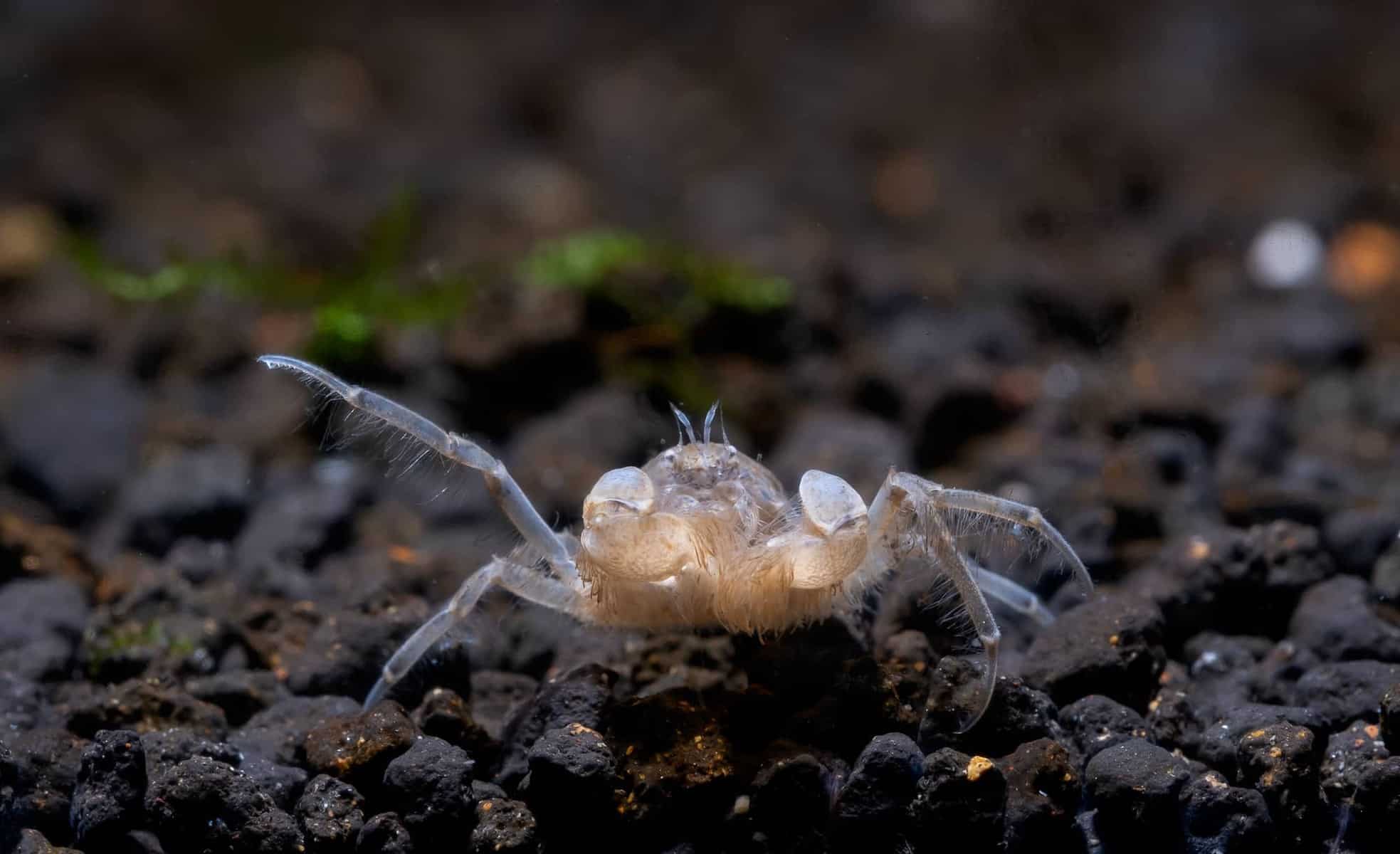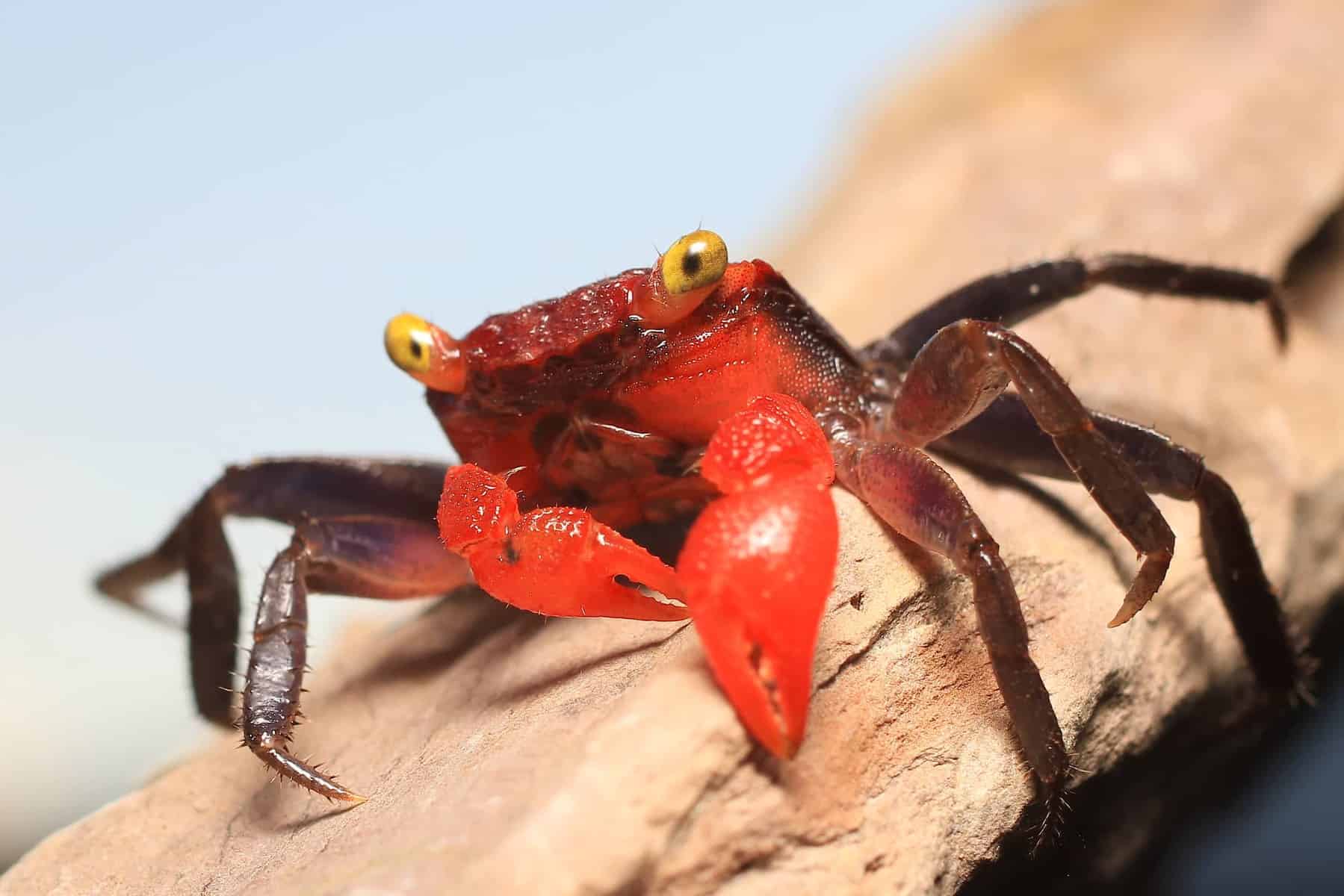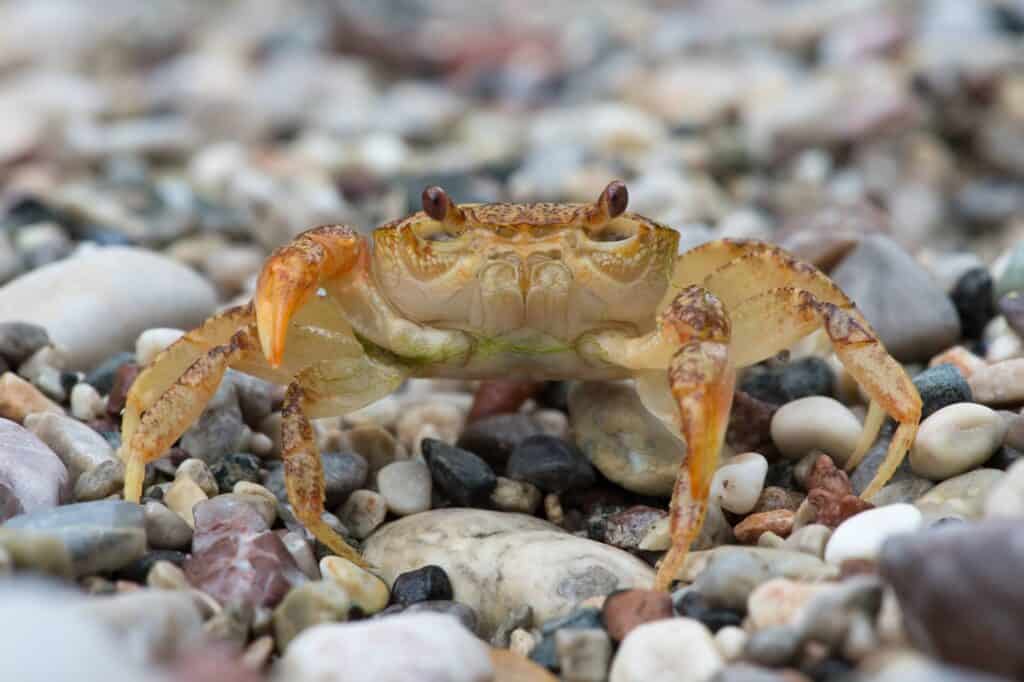When it comes to invertebrates, many aquarists immediately think of the different kinds of shrimp and crayfish that they could keep in their tank. However, there’s another group of fascinating invertebrates that can also be kept in freshwater and brackish aquariums: crabs! Unfortunately, there is still a lot of misinformation out there about these clawed critters, but hopefully, you can find some answers here to give your new pet crab the best home possible.
One main problem is that many brackish water crabs are actually advertised as being able to live in a fully freshwater tank at fish stores, such as the fiddler crab and red claw crab. Another big problem is that these crabs are then labeled as ‘fully aquatic’ when they actually need an area of land in their tank to regularly emerge from the water. Sadly, many new crab owners don’t realize this at the time because these incorrect tank conditions make it look like this is the correct care for the crab. Of course, this inevitably leads to unhealthy or dead crabs as well as disappointed aquarists.
All this conflicting information on their care can be rather confusing: which crab should you go for? Which crabs need brackish water and which crabs need freshwater? How much land access do they really need to make sure they are happy in their tank?
To hopefully clear things up a bit, this list contains five fully freshwater crab species that could be perfect for your tank!
Thai micro crabs (Limnopilos naiyanetri)

With a carapace size of around 0.4 inches (1 cm), Thai micro crabs are by far the smallest freshwater crab on this list. These tiny crabs can live fully submerged and are naturally found in freshwater rivers in Thailand. Having been introduced into the aquarium hobby not too long ago, they are still not very well-known or studied. However, they are quickly gaining popularity and becoming more readily available in fish stores.
Thai micro crabs can be quite shy and are a bit fragile, which makes them most suitable for very peaceful tanks with plenty of hiding places. They make a good addition to heavily planted dwarf shrimp aquariums and other calm freshwater setups without active/carnivorous fish or other invertebrates. Never introduce them into an improperly cycled tank or a brand new tank, as these freshwater crabs don’t respond well to fluctuating water values.
These little crabs are filter feeders that can often be found sitting in the water current ‘fishing’ for food. They may also take normal fish food as well as shrimp food and crustacean pellets that will provide plenty of calcium so that your crab is healthy and able to molt a little easier.
If you’re considering buying a Thai micro crab for your tank, a full care sheet may be found here.
You can also buy your Thai micro crabs online here!
Here you can see a huge group of Thai micro crabs eating a cube of frozen food together in a clump. More importantly, you can see that these crabs don’t eat each other or the small shrimp that comes looking around!
Vampire crabs (Geosesarma sp.)

The various colorful crabs from the Geosesarma genus (such as Geosesarma dennerle pictured at the top of this article) are often collectively referred to as vampire crabs due to their yellow eyes that almost seem to glow. Undoubtedly one of the most spectacular freshwater crabs in the hobby, their colors range from deep purple to neon orange.
The vampire crab is still understudied, but new species have recently emerged out of Java, Indonesia. Other Geosesarma sp. have been documented throughout India, the Solomon Islands, Hawaii, and largely the southeast of Asia. However, it is understood that these crabs may live between the land and the water, spending equal amounts of time in/on each.
Although they are actually not fully aquatic and therefore cannot live in a completely filled tank, vampire crabs are included here because they do still need access to an area with fresh water. If you’re interested in keeping a vampire crab, be prepared to venture into the rewarding world of paludariums, which is a tank set up that mostly consists of the land but offers some areas with water as well. If you’re interested in both aquatic and terrestrial plants, a paludarium tank would be a really great challenge!
For a small group of vampire crabs, a heated paludarium of at least 19.5 inches (50 cm) is recommended. Make sure the tank is about 2/3 land and 1/3 freshwater. Your land area can be heavily planted with various types of moss and other tropical plants. The submerged area of the tank should be cycled and the water should be relatively hard with a higher pH. Perform water changes and make sure to keep an eye on your water quality as you normally would with a regular fish tank.
Like most other crabs, vampire crabs are omnivores that can be fed a variety of food, like invertebrate pellets, insects, vegetables, fish food, and pretty much anything else.
Watch this beautiful little vampire crab foraging on moss in this paludarium tank!
Tanganyika crabs (Platythelphusa sp.)
Crabs from the genus Platythelphusa are not very popular in the freshwater aquarium hobby just yet. They are naturally found in Lake Tanganyika and are definitely an option to consider for aquarium keepers looking to set up a Tanganyika biotope tank fit for a crab that does not need to emerge on land.
These freshwater crabs originate from Lake Tanganyika, which is the second oldest freshwater lake in the world. While the distribution of these crabs has started to increase, their natural range is still poorly understood and their main concentration remains in this one area. Here, they mostly live in shallow water on a sandy substrate with plenty of rocks to hide behind. Interestingly, many of these crabs use Neothauma snail shells as their home.
Specific care requirements for these freshwater crabs are still relatively difficult to find, especially since the subspecies are often misidentified even though they vary in size. At around 2.4 inches (6 cm), these freshwater crabs are almost the largest crab on this list. A small tank is probably not a good choice for Tanganyika crabs, as like all crabs they need to be able to find a hiding place when it’s time to molt. Make sure to have a tank of at least 35.5 inches (90 cm) so that your crab doesn’t get stressed out during these times.
Make sure to remember that these crabs are not community safe and will make food out of anything that they can get their claws on. They are said to have an appetite for aquarium snails and will not hesitate to catch small or weakfish if they get the chance. Despite this, these crabs can probably be kept safely in a tank with many quick Tanganyika species of fish, like cichlids.
As with all crabs, make sure to use an aquarium hood and cover all holes to prevent them from escaping from your tank. Not sure where to find Platythelphusa crabs? Your local fish store probably won’t carry them, but they may be able to place a special crab order for you.
This Tanganyika crab is using a snail shell to live in!
Panther crabs (Parathelphusa pantherina)
Although they’re not the easiest freshwater crab to keep in the aquarium, panther crabs may make for an interesting project for more experienced crab keepers. With a carapace size of up to 3.1 inches (8 cm), they are one of the larger crabs on this list. This means they need a relatively large aquarium with at least 31.5 inches (80 cm) for just one crab.
These crabs live in and around Lake Matano in Sulawesi, Indonesia and are listed as endangered by the IUCN Red List. Nickel mining near their natural habitats has caused the water to become polluted and contaminated, leading to decreased populations. Here, these crabs like to live under roots and logs in tropical water with a pH of around 7.4.
Tank size is especially important when housing multiple panther crabs together, as they are quite aggressive both towards their own species and other fish and invertebrates. Keeping pairs or harems is usually the way to go because multiple male crabs don’t seem to go too well together in a tank setting. If you’re not sure whether a crab is male or female, simply have a look at its underside to confirm its gender. Male crabs will have a narrow abdomen plate whereas a female crab will have a much wider plate.
Although panther crabs are usually kept in a regular tank, some sources do suggest providing a small amount of land area in the form of wood or rock that reaches above the water surface; this will provide an area for your crab to perch on top if it wants. Like all crabs, panther crabs need plenty of hiding places, such as coconut hides, as they are very vulnerable during molting time.
The small spots on these crabs really earn them their name!
Freshwater pom pom crabs (Ptychognathus barbatus)
Like their saltwater namesakes, freshwater pom pom crabs lend their name from the pom pom-like filters on their claws. Still quite uncommon in the aquarium hobby and probably not too easy to find, freshwater pom pom crabs are definitely worth the search for anyone looking for an unusual addition to a small tank.
These crabs only grow to be about 1.5 inches (3.8 cm) and are known to live in tropical and subtropical regions of Asia, Africa, Australia, Taiwan, New Caledonia, and most specifically Madagascar. It is thought that these crabs may move to brackish water to spawn where their fry will continue to grow until returning back to freshwater at full maturity.
Pom pom crabs do not leave the water and can get to be a little larger than Thai micro crabs but, unlike most of the other crabs on this list, are still quite peaceful and maybe put with other community fish and invertebrates. Most sources report them paying no attention at all to even the smallest tankmates. Even dwarf shrimp, such as cherry shrimp, may be able to successfully live with these crabs as long as they are not put together in too small of a tank!
I look forward to seeing more of these small but active crabs in the future!
Make sure to pay attention to the two small pom poms on these crabs’ claws! They’re thought to help catch detritus and other food floating in the water column.
Matano crabs (Syntripsa matannensis)
The panther crab that was mentioned above is not the only colorful freshwater crab that originates from the lakes of Sulawesi. It seems as though every aquarium critter coming from this Indonesian island is more beautiful than the last! The Matano crab, also known as Syntripsa matannensis, is one of the two currently known members of the tiny genus Syntripsa.
Like pom pom crabs, the Matano crab is still a very new addition to the aquarium hobby and is understudied. These crabs don’t seem to be imported very frequently yet and you probably won’t come across them at your local fish store. They’re worth searching for a seller for though; these crabs have an almost black carapace that makes a real statement in any tank. If that’s not enough of a pop of color for you, there’s also always the purple Matano crab, which features yellow legs and a purple carapace.
Not much has been published about the Matano crab so far, but luckily, we can assume a little bit about their care requirements based on their natural habitat. For the most part, inhabitants of the Sulawesi lakes appreciate hard water with an average pH and high temperatures.
Brackish crabs
Many of the crabs sold in fish stores that are labeled as freshwater crabs are actually supposed to be kept in a tank set up with brackish water. Crab species that are commonly wrongly sold as freshwater include the red claw crab (Perisesarma bidens), the fiddler crab (Uca genus), and various kinds of hermit crabs.
Always do some research on the care your crabs need before considering having crabs as pets, and always make sure to cross-reference with multiple sources!
Conclusion
There are many species of freshwater crab available and any one of them may make the perfect addition to your small aquarium setup! While not much is actually known about these crabs in the wild, there are ways to successfully keep them in a tank if you know a little bit about where they’re naturally found and whether or not they need to emerge from the water from time to time. Always make sure to do some research before going out to pick up your pet crabs!
As you can see, freshwater crabs are constantly being discovered and subsequently introduced into the aquarium hobby, so new information about them is always being added!
If you have any more questions about freshwater crabs, have a species to add to the list, or want to share your own experiences with any of these species of crab, don’t hesitate to leave a comment below!



Hood read. Good choices. I plan on getting some Pom poms here soon. I had a Halloween crab or mon crab given to me years ago and used one of my 40 breeders to build him a home. Added some fish and before I knew it I was addict. And now I have a zoo in my house. If you have a decent sized tank to build I would recommend a Halloween/Moon crab (not fully aquatic )
I live in the tropics near to a stream and found a baby crab there and he has been in my aquarium for more than 6 months. He has moulted several times and eats raw pieces of fish. I have one plant that goes above the water line and he is growing. The tank is fresh water and I have gouramis, tetras and zebra all together.
I have no idea what type he is but he certainly is not a salty and he spends all day in a secluded spot in the tank.
Would have loved to send some pics to help identify him.
Hi,
You can try posting a photo the Aquariadise Invert Keepers FB group if you’d like, we can see if we can figure it out.
Thank you for this article!!! I loved it!! THANK YOU THANK YOU THANK YOU!!!!! 🙂
I love you! I mean, I was literally asking myself what critter would fit into my 10 gallon paludarium/riparium aquarium I was preparing to build and you publish an article on freshwater crabs … in all fairness, you published months ago, but I just saw it appear on my facebook feed. Anyway … I think the Vampire Crab might well be the answer to my quandary!
Hi! So glad the article was helpful, I had a lot of fun writing it. Not many people keep crabs but they’re super interesting, I’m actually considering vampires for my unused 60cm as well! Good luck 🙂